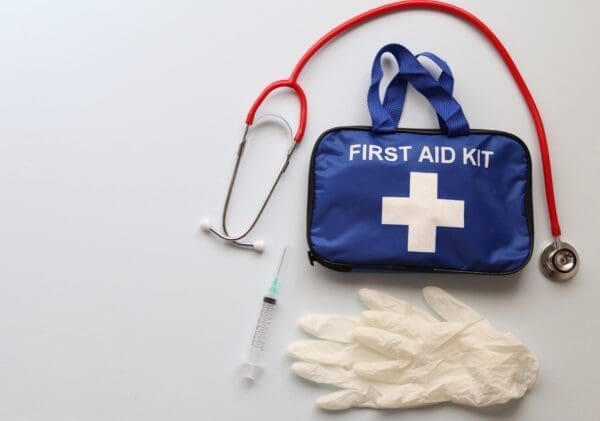14 Items You Need in Your Home’s First Aid Kit
We all aspire to never be in an emergency situation. However, in an unfortunate event, having a properly filled first aid kit at home can be a lifesaver.

Such a kit is essential in every home as it contains the equipment needed to treat minor injuries like cuts and burns and deal with more serious health issues until professional medical help arrives.
When assembling your first aid kit, you have two choices: buy a ready-made kit or make your own to meet your family’s specific needs.
Finding a pre-Here is a list of items that should be included in your home’s first aid kit:
Automated External Defibrillator:
The Automated External Defibrillator (AED) is a life-saving device used to treat sudden cardiac arrest, a state in which the heart unexpectedly stops beating.
The Avive Connect AED is a well-known model in the market praised for its user-friendly features. It is intended for use by non-medical personnel and includes clear instructions for performing successful CPR and precise defibrillation.
Basic Supplies:
The basic supplies provide the initial line of treatment before professional medical help can be sought if needed. Here’s an expanded list of the fundamental first-aid supplies to include in your kit:
- Adhesive Bandages
Adhesive bandages, also known as Band-Aids or plasters, are indispensable to any first-aid box. They can be found in various shapes and sizes, making them ideal for covering and protecting small cuts, blisters, or abrasions. Larger dressings are available when you purchase trauma kits from trustworthy sellers, but these are usually only needed for large, deep cuts that won’t stop bleeding.
This simple tool helps avoid infections by keeping the wound germ-free and limiting dirt and bacteria exposure.
- Sterile Gauze Pad and Adhesive Tape
Sterilized gauze pads are the go-to solution for larger wounds that adhesive bandages can’t cover. They are decided to absorb blood, exudates, and other bodily fluids, keeping the wound clean and aiding in the healing process while preventing further chances of contamination.
Adhesive bandages, on the other hand, are used to secure the gauze in place. If possible, opt for hypoallergenic types to reduce potential skin irritation. Having a variety of widths can be beneficial for different wound sizes.
- Antiseptic wipes or solutions
Antiseptic wipes or solutions, such as isopropyl alcohol or hydrogen peroxide, play a crucial role in wound management. They are used to clean the areas around the wound before dressing, effectively killing bacteria and other germs to reduce the risk of infections.
Some people prefer antiseptic wipes due to their convenience, as they are less likely to be spilled.
- Tweezers and scissors
A pair of tweezers in your first aid kit is handy for removing splinters, glass shards, ticks, or other small foreign objects that might get embedded in the skin.
It is best to opt for tweezers with a pointed tip for precision. On the other hand, a pair of medical scissors can serve multiple purposes, such as cutting tape, gauze, or clothing.
- Disposable sterile gloves
Gloves play a part in establishing a barrier that minimizes germ transmission while addressing wounds or handling bodily fluids. If feasible, invest in hypoallergenic gloves to accommodate people with latex sensitivities.
Medications:
While bandages and antiseptics address external injuries, including various over-the-counter and prescribed medications in your home’s first aid kit is equally important. These medications can offer immediate relief for many ailments.
Some medications to include in your first aid kit are:
- Over-the-counter pain relievers
Non-prescription analgesics like aspirin, ibuprofen, and acetaminophen serve multiple functions in the context of first aid. Aspirin and ibuprofen are non-steroidal anti-inflammatory drugs that can alleviate pain and reduce inflammation in conditions such as minor injuries, headaches, and toothaches.
In addition, aspirin can also be used during suspected heart attacks due to its ability to prevent blood clots. However, aspirin intake should only be done under medical guidance.
Meanwhile, acetaminophen is not an anti-inflammatory but is effective in pain relief and fever reduction.
Note: Aspirin should not be given to children or teenagers with flu or viral infection symptoms due to the risk of Reye’s syndrome.
- Antihistamines
These drugs are utilized to treat allergic reactions by blocking histamine, a substance within our body that reacts during allergic reactions, thereby reducing symptoms such as itching, sneezing, and hives. It is important to keep in mind that some antihistamines can cause drowsiness.
- Hydrocortisone Cream
Hydrocortisone cream is an over-the-counter topical corticosteroid that helps ease irritation and reduce inflammation. It is helpful to treat various skin diseases, including bug bites, poison ivy, eczema, and rash.
It should be used as instructed on the packaging or by a healthcare provider to ensure safety.
- Anti-diarrheal medication
Food poisoning or stomach flu can induce severe diarrhea, leading to dehydration, especially in children and the elderly. Over-the-counter anti-diarrheal drugs like loperamide can help manage these symptoms until expert medical care arrives.
Advanced items:
While the basic first kit is necessary for treating smaller injuries and symptoms, there are some advanced items that can potentially be life-saving during more severe emergencies. These items require first aid and cpr training or knowledge to use correctly. They consist of:
- Thermometer
A digital thermometer is an imperative tool for accurate and quick temperature readings in cases of fever or illnesses. Both oral and ear thermometers are easy to use, reliable, and can provide instant readings. A non-contact infrared thermometer can also be a beneficial addition, particularly when dealing with contagious illnesses.
- Instant cold packs
Also known as chemical ice packs, these devices can provide cold therapy for acute injuries such as sprains, strains, or bruises. Rapid cooling can help diminish inflammation while numbing the affected area to alleviate pain.
Unlike traditional ice packs, they don’t require freezing – a simple squeeze activates the cooling effect.
- First-Aid Manual
During a crisis, it is simple to overlook the measures necessary to treat an injury appropriately. This is why it is critical to have a detailed first-aid guidebook or training booklet in your bag.
These manuals can contain step-by-step instructions on responding to various medical crises, ranging from choking to fractures, and guidance on when to seek professional medical care.
- Emergency contact information
Aside from first-aid instructions, your bag should include a list of important emergency contact numbers. This list should consist of the phone numbers for your primary care physician, local hospital, poison control center, and other pertinent emergency services.
You should also include a document with pertinent medical data for each family member, such as known allergies, blood types, and chronic diseases.
- Space Blanket
This compact and lightweight material, often known as an emergency or survival blanket, is meant to keep body heat warm. In cases of shock or hypothermia, these blankets can reflect up to 90% of a person’s body heat, potentially saving their life. They’re comprised of heat-reflective thin plastic sheeting and can serve as a waterproof cover in an emergency.
Conclusion
Remember, once your kit has been assembled, store it in a cool, dry area that is out of the reach of children but readily accessible. Regularly inspect and replace expired products to maintain the kit’s worth.
With this manual in mind, you will be able to handle the number of medical emergencies that can occur at home.









